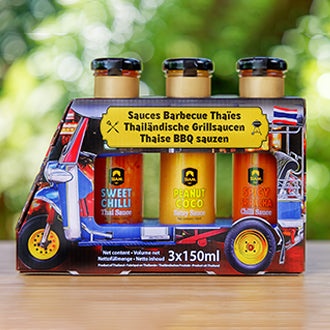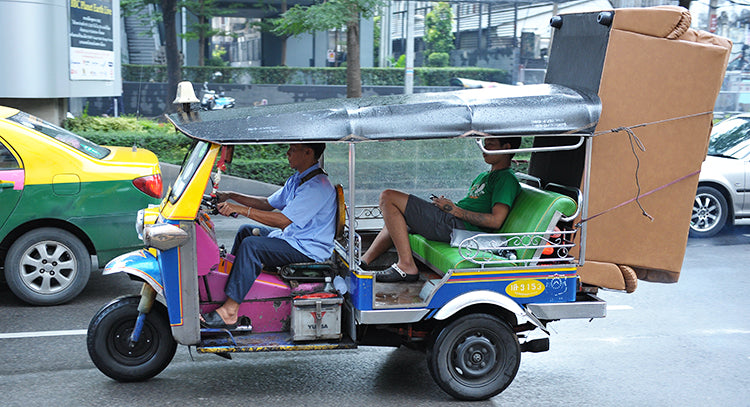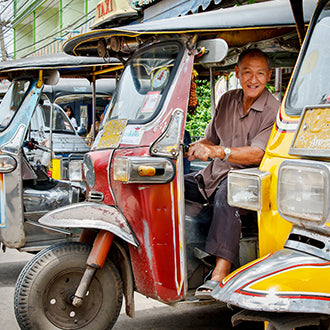My shopping cart
Your cart is currently empty.
Continue Shopping
Tuk Tuks are one of the most popular modes of transport for Thai nationals and tourists traveling around Bangkok.
This unique vehicle has become an unofficial icon for Thailand and if you've been to the country, you've undoubtedly encountered one. In this article, you'll learn everything you need to know about these popular, iconic mini cabs.

A Tuk Tuk is a motorized rickshaw that has three wheels and is open-air. The standard Tuk Tuk consists of a seat in the front for the driver and a bench in the back for passengers and can accommodate two to three people.
A modern Tuk Tuk is more likely to be open-sided and have a cloth covering to protect passengers from the sun and keep them cool.
Originally, Tuk Tuks were known in Thai as ‘Samlor’, literally translated as "three-wheeled vehicle". But it might take the unique name of Tuk Tuk from the noisy engines on the earliest models. Tuk Tuks have been around in Thailand since the 1960s and is still a popular form of transportation in big cities like Bangkok and Nakhon Ratchasima, where traffic congestion is a major problem. Now, they are readily available around Thailand, especially in tourist areas.
Tuk Tuk rates vary. They cost the same as a taxi, but have no meter. This means you can usually negotiate the fare (and you should do before any ride).
For a brief journey (1 to 2 kilometers), you should pay around 50 baht (USD1.50).

Tuk Tuks operate at a speed of 20 to 40 kph (12 to 24 mph) using a two-stroke engine. It is not designed for stability or speed but rather as a touristy open-aired way to explore the city.
Most Tuk Tuks will not travel fast, but the design allows them to zip down city streets with little trouble. If you are worried about the speed, just ask the driver to slow down.
Tuk Tuks are one of the most popular and fun things for visitors to Thailand to do, as well as being economical and providing a one-of-a-kind experience.
However, Tuk Tuks also have some drawbacks and are not the safest option for travelling, so here are some pointers to help you make sure you stay safe while using one in Thailand.

They're like motorbikes strapped to a Ferris wheel cabin on wheels. There are no seatbelts or airbags, so taking a ride on one is certainly an adventure (and that usually come with a little danger).
Make sure to find a good spot to hold while you are on a ride.
Bangkok's traffic is usually very bad, and Tuk Tuks are open-air vehicles, so sitting in one for hours on end is neither safe nor healthy. You should only make short excursions on local routes and on roads that aren’t likely to be too congested.
In addition, you shouldn't hire a Tuk Tuk for long-distance journeys, even if there is minimal traffic, because they were not designed or built with long journeys in mind. In addition, they do not come equipped with safety features, and the majority of the drivers and vehicles are uninsured, so if you plan on taking a long trip, you should utilize a taxi, van or bus instead.
The roads in Thailand are dangerous and slippery when it rains, so don’t take a Tuk Tuk during the rainy season. In addition, most Tuk Tuks are open-air vehicles, so you will get drenched from the rain.
Normally, a Tuk Tuk can accommodate two to three people. Even if you see Thais cramming five to six people in one, don't attempt the same feat yourself.
Tuk Tuks are light and easy to drive, but they are not as sturdy and stable as standard cars. If you hang over the edge too much, it is very easy to fall out of one while turning corners. If you only have two to three individuals in the back of a Tuk Tuk it is a lot more comfortable.
Tuk Tuks are not particularly stable, so do not cause a disturbance in the back of a Tuk Tuk by hanging off the side or pushing each other around when the vehicle turns corners, that may cause it to tip over.
Just sit back in your seat, hold onto the side and enjoy the ride.

When riding in a Tuk Tuk, watch out for snatch and run thieves. Also, be careful that your valuables don't fall out of your hands while the vehicle is in motion.
When riding in a Tuk Tuk, watch out for snatch and run thieves.
Also, be careful that your valuables don't fall out of your hands while the vehicle is in motion.
It's important to discuss pricing with the driver before you get in their vehicle. Some drivers may try to scam tourists, charging them an exorbitant amount for a very short ride, when in fact it should be much cheaper.
One way to avoid being overcharged is to get an approximate distance of your destination before getting into the Tuk Tuk. Then, negotiate a price with the driver before you get in. If the driver doesn’t agree on a price beforehand, walk away and ask another.
More often than not, you will usually find that they give in and agree to the price you suggested. If you're not sure how much a trip costs, you can check it from a local travel app like Grab or Lineman Taxi.

Now, Bangkok has a new electric Tuk Tuk service called MuvMi, operating in several areas of Bangkok. The vehicles are affordable and environmentally friendly being 100% electric.
It might not be the best for sightseeing, but if you need a ride around town or a quick connection to mass transit like the BTS or MRT, MuvMi could be for you. You can request a ride via their app and pay cashless by QR scan.